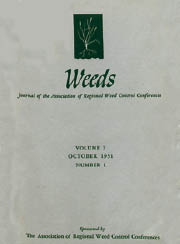Article contents
The Effect of Fenuron on Four Southwestern Shrubs
Published online by Cambridge University Press: 12 June 2017
Abstract
The injurious effects of different rates of fenuron (3-peynyl-1,1-dimethylurea) on four species of brush were recorded for two years in two different types of southwestern brushlands, the Oak-chaparral and the Chihuahuan Desert Shrub. Fenuron was more injurious to fire sprouts than to mature plants of turbinella oak (Quercus turbinella Greene) in the Oak- chaparral type especially at 2 to 8 lb/A ai. The effects of fenuron on mature plants were reduced by burning, suggesting that much of the fenuron absorbed was residual in the stems, twigs, and leaves where it was destroyed by the fire. The effect of fenuron on the fire sprouts changed only slightly between six months and two years. Gibberellic acid was applied to sprouts and mature oak plants appeared to slightly reduce the injurious effects of some rates of fenuron during the first six months but no gibberellin induced differences were observed after two years. In the Chihuahuan Desert shrub type, tarbush (Flourencia cernua DC.) and whitethorn (Acacia constricta Benth.) were about equally susceptible to injury by fenuron with creosotebush (Larrea tridentata (DC.) Cov.) slightly more resistant. Summer applications just before the rainy season were most effective and 4 lb/A combined high shrub kill with greatest grass growth.
Although 8 and 16 lb/A ai killed and injured both grasses and shrubs on the oak plots, grass naturally reseeded into these plots within six months after treatment, but on the Chihuahuan Desert area grass had not recovered on the plots treated at 8 lb/A after two years. This difference in grass re-establishment was probably due to rainfall differences which would give differences in leaching of fenuron. Palatability of the grasses in the oak plots increased due to fenuron treatments, particularly on the heavily treated plots. These studies indicate that moderate rates of fenuron, applied just prior to favorable seasonal rains and repeated at several-year intervals, may be used to control turbinella oak sprouts and mature Chihuahuan Desert shrubs. However, treatments would only be economical where high forage and watershed values would result.
Information
- Type
- Research Article
- Information
- Copyright
- Copyright © 1963 Weed Science Society of America
References
Literature Cited
- 1
- Cited by

